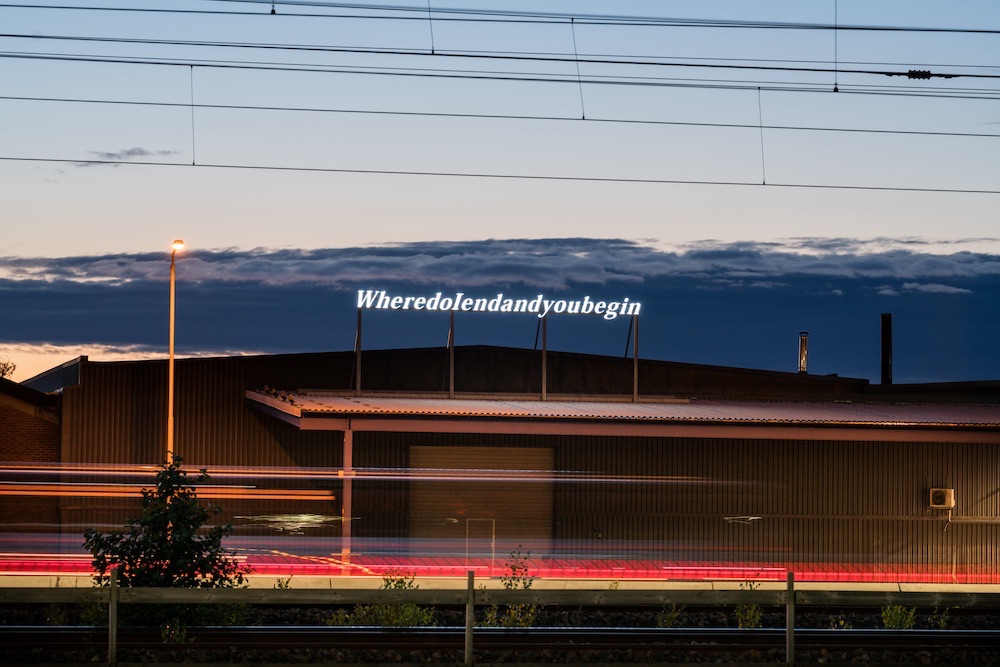Denise Ferreira da Silva
Invisible\Obliterating
- 03.12.2020
- EssayJusticeExhibition/Program DesignDenise Ferreira da SilvaDouglas LopesLaís MachadoDiego AraújaMichelle MattiuzziIagor PeresCamilla Rocha CamposDiego CruxPedra CostaJota MombaçaLorran DiasTiago GualbertoMayara AmaralJuliana dos SantosJennyfer NascimentoDavi PontesCastiel Vitorino BrasileiroAna PiDaniel Ananias da SilvaCarolina Teixeira-ItzáCurating
Laís Machado and Diego Araúja, Mãe Pavorosa, 2020. Video performance, 19:20 minutes. Courtesy of the artists.
I.
For a few years now, I have been attending to the contemporary artistic practices of Black Brazilian artists, many of whom work in a truly interdisciplinary manner that includes performance, visual arts, and creative writing.1 Facing squarely the double challenge of commodification and representation, these artists foreground the body and history in a way that not only dodges its immediate apprehension as intellectually consumable but even leads in opposite directions.2 In these works, the body, biology, history, and their significations combine in a form of presentation that refigures Blackness to return political/symbolic violence (that of representation) in a movement that conceals and confronts. This happens because the works of many, if not most, of this generation of Black performers, poets, and writers, return Blackness to the scene of subjugation—the moment when being killed or raped is always more than a possibility—not to reveal its truth, but to nullify skin-deep determinations and interpretations and render Black depth as negativity (refusal) and fugitivity (rebellion). This is possible because Blackness is the tool of raciality that most effectively renders the horizon of death.3
Laís Machado and Diego Araúja, Mãe Pavorosa, 2020. Video performance, 19:20 minutes. Courtesy of the artists.
This raises a double question for curators and directors of art spaces and programmes. How can they make space for such figurations of violence without regarding the work as evidence (historical, anthropological, or sociological)? How do they develop exhibitions that enable the intellectual appreciation of figurations of violence that cannot be neatly reduced to evidence, in order to conjure up the proper critical-ethical-aesthetic subject? My focus in this commentary is not, however, on the moment of appreciation; it is on exploring how the works anticipate and undermine this possibility of becoming evidence. I am compelled to add this question of evidence to the conversation about contemporary art and art events with an explicit ethical-political mandate.
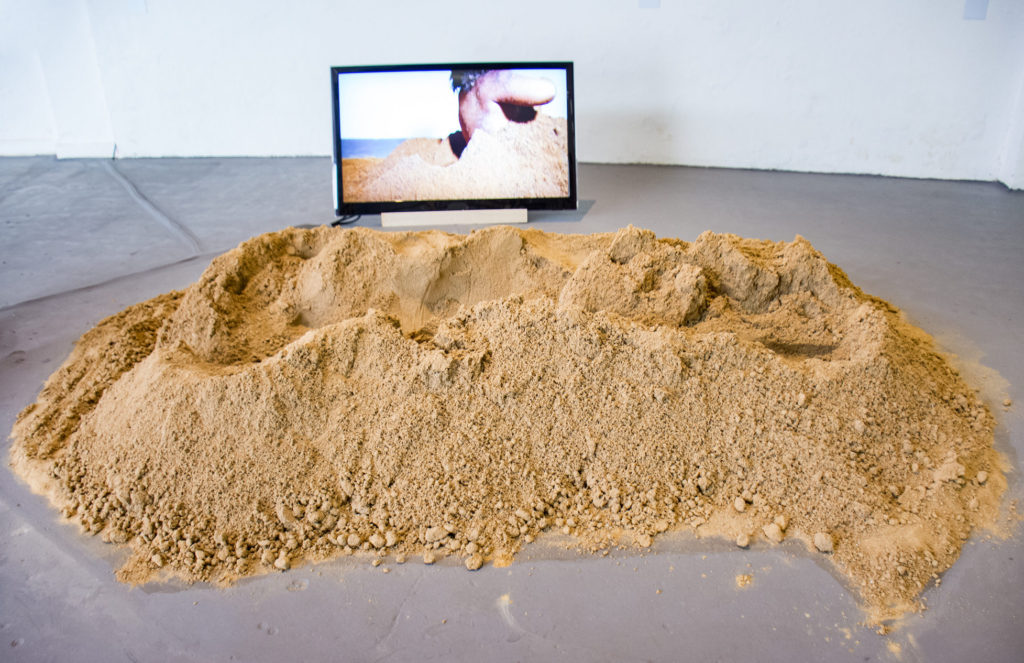
Jota Mombaça, Soterramento [Burial], 2014–2017. Video installation. Photo: Douglas Lopes. Courtesy of the artist.
II.
Fear for his life is what a police officer claims in order to justify the otherwise unacceptable, fear of the dark street, fear of that Black person—that is, fear of the always-already devious, invisible, and dangerous body. Every police killing of an unarmed Black person that goes unpunished is an instance of this operation, of the Black body made evidence of the certainty of total violence. How and why this happens is not as relevant as the fact that it is a result of raciality as a tool of modern representation, that is, of Blackness as a post-Enlightenment political/symbolic device. As a tool of the racial dialectic, Blackness renders the slain Black person solely responsible for her death.4
To put it another way, the Black body—in these situations as well as in the daily encounters with the relentless performance of racial violence, in small and large gestures designed to humiliate, silence, or loudly express indifference—is the evidence of unbecoming mental (moral or intellectual) “contents.” The Black body is rarely appealed to signify the juridico-economic conditions (the slave trade and slavery) that characterised the extraction and expropriation of persons and their material capacity (labour) from the African continent. This being the case, let us attend to, track, and trigger the ways in which a Black body, my Black body, each and every Black body refuses, confronts, and refigures the fear associated with Blackness. These artists assemble a form of presentation that releases Blackness from the obligation to respond for what demands its obliteration. While these works do not stabilise into an identified whole, something does become apparent in each of them when it is considered in relation to another work.
Jota Mombaça, Soterramento [Burial], 2014–2017. Video installation. Photo: Douglas Lopes. Courtesy of the artist.
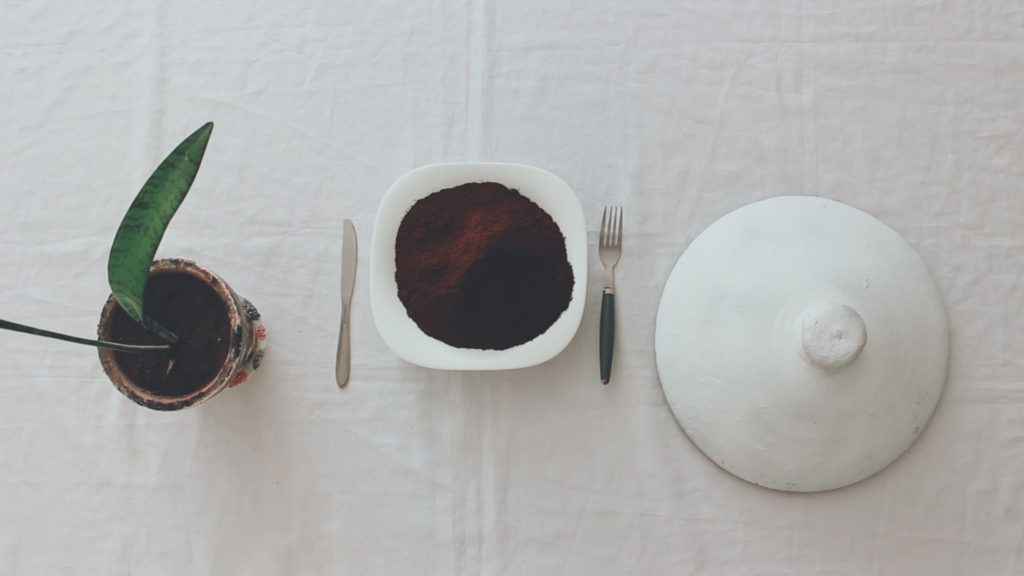
Laís Machado, Canção das Filhas das Águas, 2020, Video. 20 minutes. Courtesy of the artist.
This commentary is therefore more of a reading than a reflection on these works. It seeks to extrapolate the sort of demands that refusal and confrontation make to contemporary art. I am interested in raising a question: Can contemporary art comport refusal and confrontation, and how might it do so? I hope this text suggests the kinds of question that must be asked, bringing awareness to what cannot be taken for granted. What will have to be relinquished and what must be welcomed?
Unfortunately, I cannot consider these truly relevant questions here; I can only venture a possible reading, as opposed to an analysis, of the works. But reading actually takes place later, after I consider an individual work, and read and hear the artist commenting on it, after I encounter another work in which I find something that recalls yet another that I encountered earlier, and so on. Reading, as performed here, is a form of presentation. It neither stabilises nor intends to stabilise the “somethings” I find in all of these works as their unique characteristic or as anything exclusive to their makers. In their form of presentation, that “something” refers to the context, which the work seems to be already anticipating and confronting, something for which the work itself already offers a reading, that is, a re/de/composition. Regardless of how it performs this re/de/composition, each work anticipates a specific public, a public that comes to it with preconceived views of what the work “represents,” rather than with an open attitude of appreciation. This public approaches the work looking at it as evidence, of something which the work presumably, but also always already, can only prove to be true or untrue.
Laís Machado, Canção das Filhas das Águas, 2020, Video. 20 minutes. Courtesy of the artist.

Laís Machado and Diego Araúja, Mãe Pavorosa, 2020. Video performance, 19:20 minutes. Courtesy of the artists.
Laís Machado and Diego Araúja, Mãe Pavorosa, 2020. Video performance, 19:20 minutes. Courtesy of the artists.
III.
I find that “fierce” is the best descriptor of the way in which these works reflect racial violence without inflicting it. This split between reflecting and inflicting occurs in the rendering of Blackness as a fracture or an imperfect mirror that returns violence. This happens when the works recall the body’s symbolic capacity (as aesthetic referent) from its evidentiary design (as a biological or social scientific object), because the works anticipate that the body will appear as evidence for the audience. Put differently, a crucial characteristic of these works is their confrontation of a generalised audience’s desire for authenticity.Take, for example, Laís Machado’s performance entitled Mãe Pavorosa (Dreadful Mother), in which trance allows for a simultaneous fragmentation and complexification of the female, releasing it from any given racial, sexual, or gender identity. As Machado explains:
Mãe Pavorosa is a multilingual work. An initiation ritual. A celebration of the emancipation of female bodies that are at the limits of identity. A collective trance based on the appropriation and decolonisation of love and violence [and explores] the violent aspects related to water (head of water, waterspout, currents, waterfalls, etc.), present in abundance in nature but not incorporated into the female archetypes built from it. […] The first imprisoned in the archetype, and the second in the taboo. Mãe Pavorosa is a transdisciplinary work that materialises from everything that the body in a trance can produce, manipulate, and convert: spaces, images, sounds, textures, translations, and movement.5
Trance is key to Machado’s presentation of the Black body. Intense and immersive, it releases the sexual body from biological determinism without renouncing its physicality; that is, it upholds the sexual body as both container of and contained by sexual identifications, deftly returning projected fear as vulnerability and confrontational auto-exposure. Turning to what she considers the positive meanings of violence—that it, vehemence, exuberance, and enthusiasm—Machado situates the presentation of a “female body” at the limits of two dimensions of racial and gender subjugation, namely, identity and physicality.
In Machado’s performances, the sexually unspecified but gendered female Black body confronts the skin-deep appropriations that render it a site of deployment of an authority that should have no place in post-Enlightenment political architectures. The body, as if in trance, is exposed to and yet released from its pre-occupation as a referent of authorized total violence. Put differently, trance releases the body from its role in the justification of violence—the physical and symbolic violence that characterises cis-gender-sexual—which is said to be done as a self-preserving gesture. And yet, as the daily publicised but never heard state-perpetrated and state-authorised killings of Black persons testify, total violence does indeed operate in this world. Unhinged from the category of sex, released to confront and expose gender’s biological basis the body presented in Machado’s Mãe Pavorosa invites the audience to consider its own dispositions and preoccupations regarding gender/sexual difference. This may include the impossibility of deciding whether audience members request or expect the return of violence.
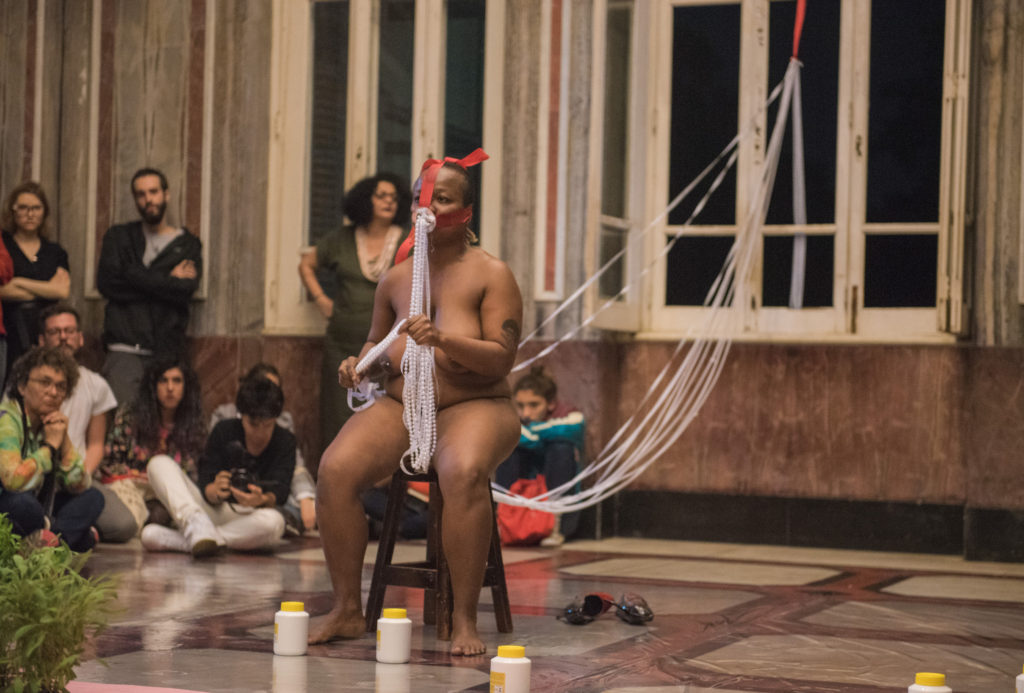
muSa Michelle Mattiuzzi, Merci beaucoup, Blanco!, 2018. Performance. Photo: Francisco Costa. Courtesy of the artist.
muSa Michelle Mattiuzzi, Merci beaucoup, Blanco!, 2018. Performance. Photo: Francisco Costa. Courtesy of the artist.
In Merci beaucoup, Blanco!, muSa Michelle Mattiuzzi activates the Black cis-female body as a reference to total violence in a formal exercise in which the audience witnesses her deliberately and delicately touching her own body as she turns it into a historical canvas and a device for symbolic de/composition. In this performance, a silent Mattiuzzi—with an artefact covering her mouth, like the mask used to torture enslaved persons—slowly and systematically paints her naked body white. Through her hands, the symbolic violence that is the celebration of whiteness—and the whitening ideology in Brazil—becomes both agent and effect of artistic expression. Explicitly presented as a referent, and thus weaponised, the cis-female Black body6 in Mattiuzzi’s work returns historical and representational violence, which is part of everyday existence.
“For at least three decades,” she states, “I have carried my body throughout the world. I live with humour, foul humour, lack of love, joy, happiness, sadness, pain, love, passion, colours, and many other things that do not fit in words.”7 That is, she activates the Black body against representability by returning it to history and the authorised violence and ignored violations that marked slavery. These precise historical references, invoked in gestures and objects, confront by simultaneously refusing and citing the expectations of cultural and racial difference—in particular, the figure of the hypersexual Black female, which Mattiuzzi dissolves by rendering her own body an object of both love (delicate self-touching) and violence (piercing and torture devices) simultaneously. These gestures pre-empt any presumed innocence on the part of the critically aware audience with regard to the way in which the symbolic production of Blackness as deviousness rehearses the very authority that is manifested in the physical violence of enslavement and police shootings.
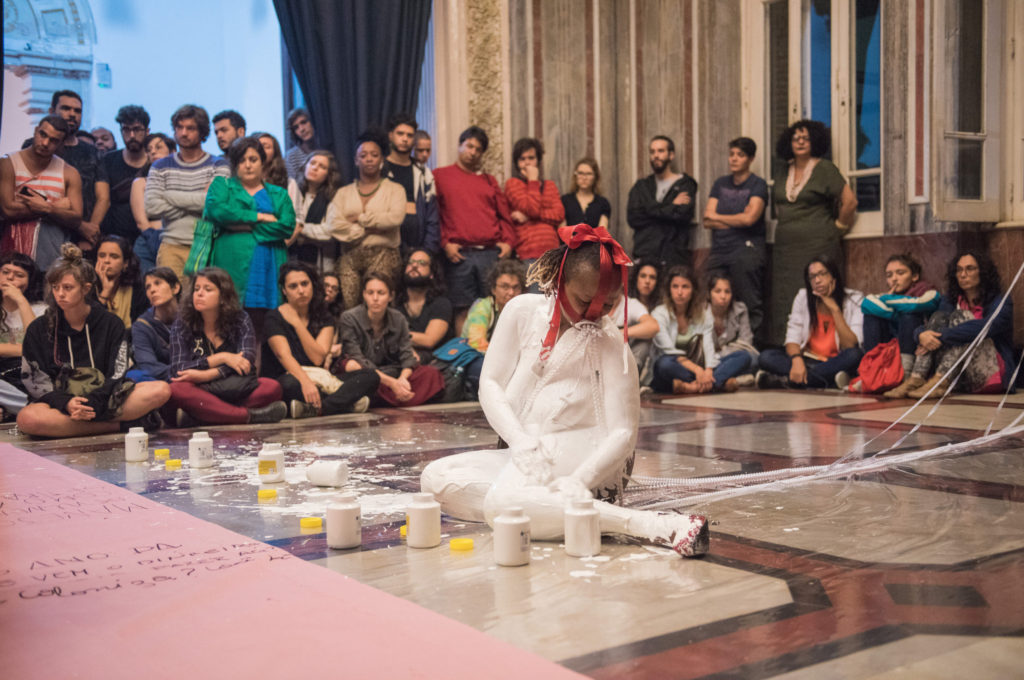
muSa Michelle Mattiuzzi, Merci beaucoup, Blanco!, 2018. Performance. Photo: Francisco Costa. Courtesy of the artist.
muSa Michelle Mattiuzzi, Merci beaucoup, Blanco!, 2018. Performance. Photo: Francisco Costa. Courtesy of the artist.
In the work of Machado and Mattiuzzi, I identify a form of presentation that does not allow the Black female body to remain “in the hold” of pre-existing conceptions or the assumptions and anticipations that accompany racial and cis-heteropatriarchal representation. This confrontation is much more complex and multifaceted than can be conveyed in a commentary, but let me highlight two moments of their version of this form of presentation. On the one hand, by commenting on the biological (Machado) and the historical (Mattiuzzi), the artists trouble any attempt to apprehend the Black female body, to resolve it as a physical (scientific or historic) container of a particular sexual-gendered subjectivity. On the other hand, since they do this by rehearsing in voice or gesture the violence that accompanies or is intrinsic to racial representation, they also expose some of the ways in which the Black body has been confined to a subjectivity that can only express total violence. Whatever responses or reactions these two performances provoke from the audience (and critics), it is safe to assume that, much as the work’s trajectory and effects will go beyond the artist’s intention, so too will it exceed the response of the audience.
One might say that this is true for any artwork; however, since these artists explicitly reject assumptions regarding gender/sexual identity and constructions of Black femininity, Blackness adds another dimension for LGBTQI2+ and BIPOC artists, namely, the mediation of racial and cultural (social) difference, which attaches to the meanings given to the works by racial representation. This is all the more crucial, since in the works of these artists the body becomes the site of experimentation with the unmaking of discourses that write it as dangerous, of a critique that falls short of exposing the criminalisation of Black persons and territories, and of justice that fails to account for the already dead. In both performances, Blackness pierces the visible—as the presupposition in their presentation of the haptic visibilising of the possibilities of existing otherwise, underneath, and within the optic invisibilising of colonial, racial, and gender/sexual violence—to conjure its discursive and historical layers. In both, the symbolic can no longer be distinguished from the lethal, as Black skin is both the outermost layer and innermost evidence of modernity’s inherent coloniality. Releasing the Black female body from fear, a projection of the very violence that has facilitated the construction of the world as we know it, these artists enact a confrontation with the legacy that is spelled out in discourse, dissected in critique, named, explained, and denounced, but continues to leave us only one recourse—setting the world on fire.
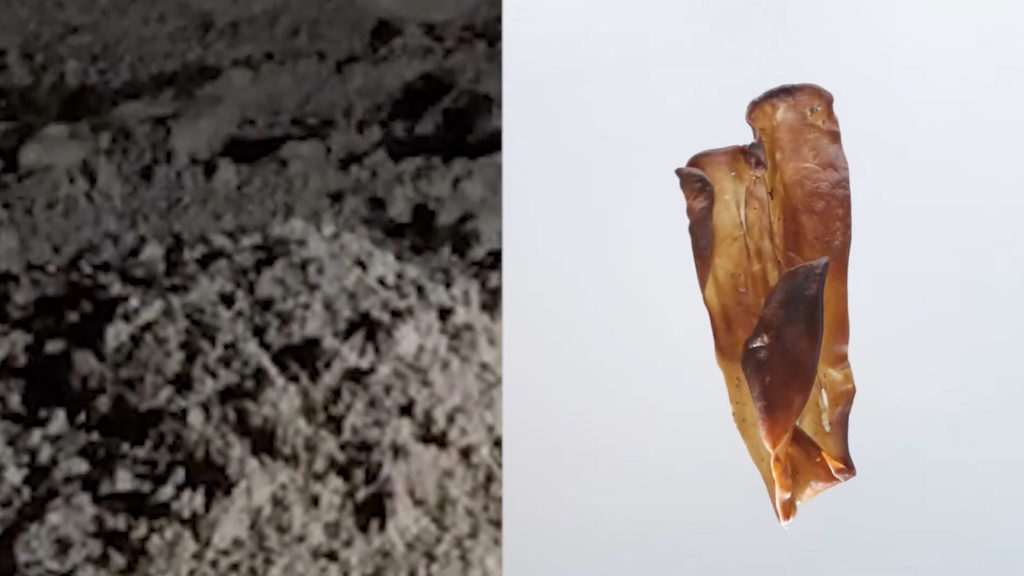
Iagor Peres, Ali entre nós um invisivel obliterante, 2020. Video performance, 8:33 minutes. Sound: Thelmo Cavalcanti. Courtesy of the artist.
Iagor Peres, Ali entre nós um invisivel obliterante, 2020. Video performance, 8:33 minutes. Sound: Thelmo Cavalcanti. Courtesy of the artist.
IV.
The work of these artists—and of academics too, for that matter—is often presupposed to figure the particular subjectivity of the artist, which arrives always already too late, after the work and the intention that animated it have been apprehended as representative of a given socio-historical experience, including gender/sexuality and raciality. Though it is important to the emergence of what I am calling “intellectual consumables,” it matters little whether the public is “woke,” or whether their position in regard to colonial and social subjugation is intuitive, or sophisticated and critical. What is significant here is that these works intervene aesthetically through a form of presentation that disturbs these expectations.
Let me conclude with a couple questions: What happens when the work, in addition to carrying the burden of racial and gender/sexual representation and the allure of the artist’s intention, also accrues layers of mediation, including the curator’s statements and the other works she plans to include in a major exhibition? How can the art event, as a composition, host the subtle but fiery fierceness of such works when these trouble the very ethico-political content and orientation that inform the event’s composition?8 These questions are all the more relevant to large art events such as biennials and triennials, whose propositions are often explicitly political, insofar as they critically address colonial, social (racial, gender/sexual, body, and neurotypical), and global subjugation.
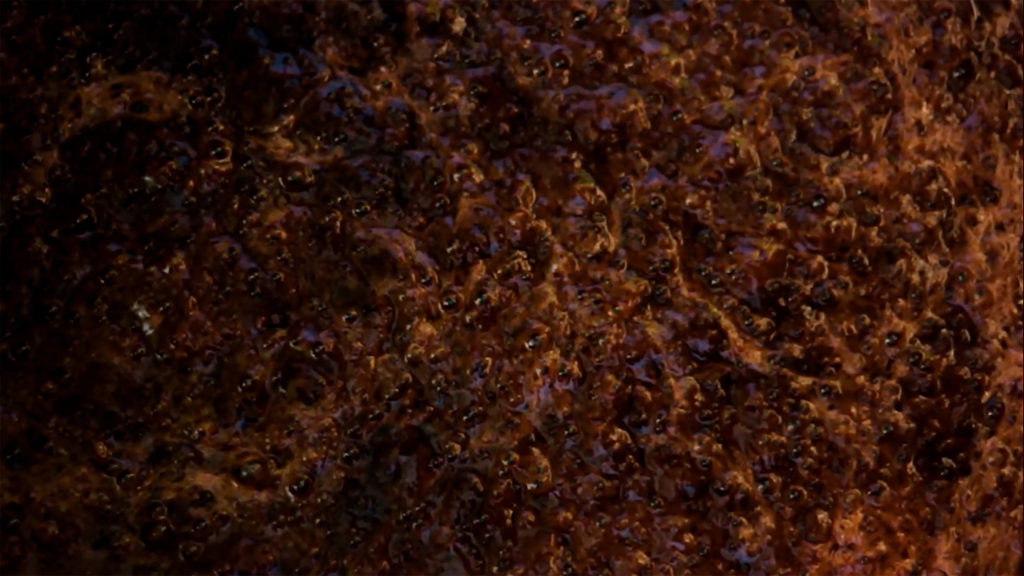
Iagor Peres, Ali entre nós um invisivel obliterante, 2020. Video performance, 8:33 minutes. Sound: Thelmo Cavalcanti. Courtesy of the artist.
Iagor Peres, Ali entre nós um invisivel obliterante, 2020. Video performance, 8:33 minutes. Sound: Thelmo Cavalcanti. Courtesy of the artist.
In the text component of Ali entre nós um invisivel obliterante (There among us something invisible and obliterating), Iagor Peres comments on Blackness’s capacity as pelematerial (skinmaterial), a term that extends from the “invisible to the unsayable,” and refers to the moment when what is not seen exposes “the other densities that permeate us.”9 This work, which also includes sculptures made of large pieces of dark brown-coloured skin, hints at the context from which to join in the conversation I am proposing here. In it, as in the other works that inspired this commentary, I discern a broader interrogation of the position of the intellectual consumer. This interrogation begins with the realisation that everything seems to have already been said.
So what is left after critique, after naming, explaining, demanding, protesting, and burning? What is left for us to do? Can art open a way into, through, across, and then beyond the naturalising gestures that feed the forces of representation? The works I have discussed seem to suggest that there is, but that getting there, activating this potential, requires inhabiting a rather uncomfortable place, where lie both the “invisible and obliterating” (representation) and the “other densities” that must never become evidence.
NOTES
1 I am thinking of the works of muSa Michelle Mattiuzzi, Paulo Nazareth, Jota Mombaça, Lorran Dias, Iagor Peres, Pedra Costa, Tiago Gualberto, Mayara Amaral, Juliana dos Santos, Jennyfer Nascimento, Davi Pontes, Castiel Vitorino Brasileiro, Ana Pi, Camilla Rocha Campos, Laís Machado, Daniel Ananias da Silva, Carolina Teixeira-Itzá, and Diego Crux, among others. Some of their work can be seen on EhChO.org.
2 This implies a distinction between commercial and intellectual consumption, which cannot be developed here because it requires a discussion of the market in general, and of a specific market for political art. This discussion would have to consider and complicate many aspects of Anton Vidokle’s argument in “Art without Market, Art without Education: Political Economy of Art,” e-flux Journal 4 (March 2013), https://www.e-flux.com/journal/43/60205/art-without-market-art-without-education-political-economy-of-art/.
3 For a discussion of how raciality is produced globally as the horizon of death, see Denise Ferreira da Silva, Toward a Global Idea of Race (Minneapolis: University of Minnesota Press 2007).
4 I have discussed this in several articles: see in particular Denise Ferreira da Silva, “No-Bodies: Law, Raciality and Violence,” Griffith Law Review 18.2 (August 2009): 212–236, and “The Scene of Nature,” in Contemporary Legal Thought, ed. Christopher Tomlins and Justice Desautels-Stein (Cambridge: Cambridge University Press, 2017), 275–289.
5 See Laís Machado’s portfolio, https://plataformaaraka.wixsite.com/araka. Translated by the author.
6 This was also noted in Alexandre Araújo Bispo, “Michelle Mattiuzzi: Corpo, festa e dor,” O Menelick – 2o Ato (August 2013), http://www.omenelick2ato.com/artes-da-cena/danca-e-performance/corpo-festa-e-dor. Translated by the author.
7 Quoted in Alexandre Araújo Bispo and Fátima Lopes, “Presenças: A performance negra como corpo político,” Harper’s Bazaar Art Brasil (April 2015): 106–112. This excellent analysis of Michelle Mattiuzzi’s and Paulo Nazareth’s work focuses on the ways in which the body directly confronts the prevailing Brazilian racial discourse in their work. In the case of Mattiuzzi, Bispo and Lopes note how this particular performance “challenges the collection of stereotypes still linked to the Black body in the Brazilian imaginary” (109). Translated by the author.
8 Here I am thinking of events such as the 56th Venice Biennale, the 22nd Sydney Biennale, and the inaugural Sharjah Architecture Triennale in 2019.
9 This piece was commissioned by EhChO.org and is available at https://ehcho.org/conteudo/ali-entre-nos-um-invisvel-obliterante.
ABOUT THE AUTHOR
Denise Ferreira da Silva is Director and Professor at the Social Justice Institute-GRSJ at the University of British Columbia. She is the author of Toward a Global Idea of Race (University of Minnesota Press, 2007) and A Dívida Impagavel (Casa do Povo, 2019), and co-editor of Race, Empire, and the Crisis of the Subprime (Johns Hopkins University Press, 2013).
Her articles have been published in interdisciplinary journals including Social Text, PhiloSOPHIA, Griffith Law Review, Theory & Event, and The Black Scholar. Her art-related work includes the films Serpent Rain (2016) and 4Waters-Deep Implicancy (2018) (with Arjuna Neuman), the practices Poethical Readings and Sensing Salon (with Valentina Desideri), the platform EhChO.org, as well as exhibitions and talks at venues such as Centre Pompidou, Paris; Whitechapel Gallery, London; Museu de Arte de São Paulo (MASP); the Solomon R. Guggenheim Museum, New York; and the Museum of Modern Art, New York.
She has also contributed to publications for major events such as Liverpool Biennial, Bienial de São Paulo, the Venice Biennale, and Documenta 14, and to journals including Canadian Art, Texte zur Kunst, and e-flux.



